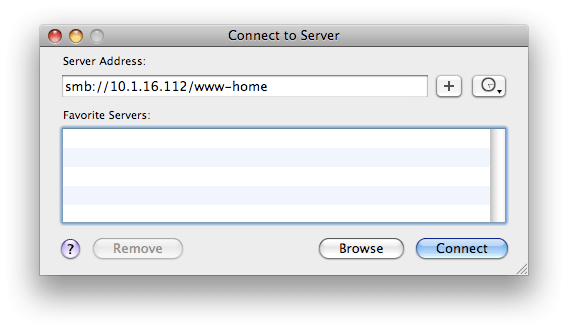
The result is that all these hidden files waste about 248 MBs: gets the number of kilobytes occupied by these files, and then sums those kilobytes up into the total amount using awk. Not only can that be painful if you were to make a backup of your files with anything but AFP but, although not big individually, they do accumulate quite some space wastage as well. It might not look much at first but it turns out that these little hidden files can accumulate quite a bit, as you can imagine, having one for each file you create. Good news, nothing there, but notice that we did lose the execute permission on the file! 0 20 Jan 17:28 test2.txtĪnd now have a look at it via the AFP mounted location:ĭrwx- 1. Now let’s try it the other way around and create a file in the SMB share:ĭrwx- 1. AppleDouble and hides the fact, of course, as it is a hidden folder as far as it is concerned.
#Mac file sharing smb vs afp mac os x#
0 20 Jan 17:12 text.txtĪs you can see, Mac OS X happily created the hidden folder. Now let’s have a look at the same folder via the SMB mount:ĭrwx- 1.

There is nothing suspicious that can be seen there. Next, I’m going ahead and create a simple, single, empty text file via AFP: _smb._tcp.local/Data on /Volumes/Data-1 (smbfs, nodev, nosuid, mounted by. _afpovertcp._tcp.local/Data on /Volumes/Data (afpfs, nodev, nosuid, mounted by. Volumes/Data is mounted via AFP while the /Volumes/Data-1 is mounted via SMB: I have the same remote location mounted via AFP and SMB, in my case, it’s my Data folder.
#Mac file sharing smb vs afp windows#
Windows does a similar trick by creating a Thumbs.db file, however, with Mac you will get a metadata file for each and every file, and you won’t even notice until you look into the folder with any other protocol than AFP, say SMB or FTP. Within these folders, there are files with the same name as the actual files that keep metadata information about them. One thing with AFP is that it keeps a lot of hidden files in folders called. So it was time to finally move from AFP to SMB and by doing so I discovered two things that make me recommend to never, ever use AFP to begin with! The many, many hidden files. something that non-Apple devices could see and understand too. But, with the appearance of some non-Apple devices, it was time to change and move to something more liberal of a file protocol, i.e. It didn’t cause any issues and I didn’t see anything wrong with that either, after all, it’s Apple protocol to Apple device. The information out there was so sparse that I decided to document this nightmare of a network file system admin to hopefully save others a few grey hair…Īs said above, it all began with the simple task of switching my NAS from the AFP to the SMB protocol and reconnect my devices to it, not thinking of discovering a sinister but obviously failed plot of world domination or perhaps just a “well, we do it differently” situation as it happened so often in the early days of IT.įor a long time, my NAS was quite happily running on AFP and my Mac connected to it. On the verge of going mad, I turned to a high-scale googling effort, trying to figure out what went wrong.

The strange thing about it was that when looking at the same folder via SMB from my Raspberry Pi, the files were there and I could happily read them, but then looking at the same folder via AFP or SMBon my Mac, the files were gone. :O I thought of it as a simple “turn off the one protocol and turn on the other one” reconfiguration, but after doing so, to my surprise, I discovered that some files went missing. Click Options to make sure either the SMB or AFP connection protocol and the user account are enabled.I recently wanted to reconfigure my NAS from Apple’s AFP (Apple Filing Protocol) to “regular” SMB (Samba), given that there appeared some non-Mac devices at home lately.

To enable File Sharing on your Mac, open the System Preferences, then open Sharing pane and select the option for File Sharing. Not only does it let you manage all kinds of files on your iPhone iPad, it also supports Wi-Fi file sharing from Mac, Windows, Linux, Time Capsule, NAS(WD NAS, Toshiba NAS…), Sandisk iXpand Flash Drive, WebDAV Server, FTP Server, iCloud, Dropbox, Google Drive, OneDrive, Box, etc. If you are looking to access Mac file sharing from iPhone and iPad, you would need a third-party SMB client app. On your iPhone or iPad however the stock Files app can’t help you connect nearby devices. In an earlier article, we already shared with you the steps to connect to Mac file share from Windows PC.

You can enable this feature to turn your Mac into a file server, then connect other Macs, Windows computers and mobile phones to your Mac to transfer files between them. Mac users can find the File Sharing feature in System Preferences > Sharing section.


 0 kommentar(er)
0 kommentar(er)
